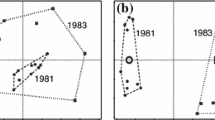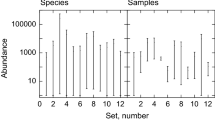Summary
Several measures of interspecific association are compared. Dispersion and covariance are limited in value because they respond to the commonness of the species compared. Correlation is not so limited but it responds to discrepancies in commonness among the species. The practical result of these relationships between commonness and association is that only the most common species can occupy periferal positions in a species ordination. Rare species are relegated to positions near the center not on the basis of their phytosociological pattern but simply because of their rarity. Both Cole's index of association and the tetrachoric correlation overcome the problem imposed by the relationship between ordination position and species commonness and they both produce very similar results. The effect of differing numbers of species on the ordination configuration is examined using both Pearson's correlation and Cole's index. The basic pattern of the ordination is set with the first few species when Cole's index is used, however, since rare species are given more weight in the analysis with this index, the addition of several very rare species can change the configuration of the ordination.
Similar content being viewed by others
References
Austin, M. P. & I., Noy-Meir. 1970. Principal component ordination and simulated vegetational data. Ecology 51: 551–552.
Brown, R. T. & J. T., Curtis. 1952. The upland conifer-hardwood forests of northern Wisconsin. Ecol. Monogr. 22: 217–234.
Carroll, J. B. 1961. The nature of data, or how to choose a correlation coefficient. Psychometrika 26: 347–372.
Colé, L. C. 1949. The measure of interspecific association. Ecology 30: 411–424.
Curtis, J. T. & R. P., McIntosh. 1951. An upland forest continuum in the prairie-forest border region of Wisconsin. Ecology 32: 476–496.
Elderton, W. P. 1953. Frequency Curves and Correlation. Harren Press, Washington, D.C. 272 pp.
Goff, F. G. 1971. Derivation of species succession vectors. American Midland Naturalist 87: 397–412.
Goodall, D. W. 1970. Statistical plant ecology. Ann. Rev. Ecol. Syst. 1: 99–124.
Gower, J. C. 1966. Some distance properties of latent root and vector methods used in multivariate analysis. Biometrika 53: 325–338.
Lambert, J. M. & M. B., Dale. 1964. The use of statistics in phytosociology. Adv. Ecol. Res. 2: 55–99.
Orlóci, L. 1967. Data centering: A review and evaluation with reference to component analysis. Syst. Zool. 16: 208–212.
Orlóci, L. 1968. Definitions of structure in multivariate phytosociological samples. Vegetatio 15: 281–291.
Pearson, K. 1914. Tables for Statisticians and Biometricians. Cambridge University Press.
Preston, F. W. 1948. The commonness and rarity of species. Ecology 29: 254–283.
Seal, H. L. 1964. Multivariate Statistical Analysis for Biologists. John Wiley & Sons, Inc., New York, 207 pp.
Sokal, R. S. & P. H. A., Sneath. 1963. Principles of Numerical Taxonomy. W. H. Freeman, London.
Swan, J. M. A. 1970. An examination of some ordination problems by use of simulated vegetational data. Ecology 51: 89–102.
Whittaker, R. H. 1967. Gradient analysis of vegetation. Biol. Rev. 42: 207–264.
Williams, W. T. & J. M., Lambert. 1961. Multivariate methods in plant ecology. III. Inverse association — analysis. J. Ecol. 49: 717–729.
Yarranton, G. A. 1965. Prineipal components analysis of data from saxicolous bryophyte vegetation at Steps Bridge, Devon. Can. J. Bot. 45: 93–115.
Author information
Authors and Affiliations
Additional information
Nomenclature of species is given in Table 1.
Research supported by the Eastern Deciduous Forest Biome Project, US-IBP, funded by the National Science Foundation under Interagency Agreement AG-199, BMS69-01147 A09 with the Energy Research and Development Administration — Oak Ridge National Laboratory. Research also supported by the U.S. Energy Research and Development Administration under contract with the Union Carbide Corporation. Contribution No. 240 from the EDFB, US-IBP. Publication No. 790. Environmental Sciences Division, ORNL.
Rights and permissions
About this article
Cite this article
Goff, F.G. Comparison of species ordinations resulting from alternative indices of interspecific association and different numbers of included species. Vegetatio 31, 1–14 (1975). https://doi.org/10.1007/BF00127870
Accepted:
Issue Date:
DOI: https://doi.org/10.1007/BF00127870




